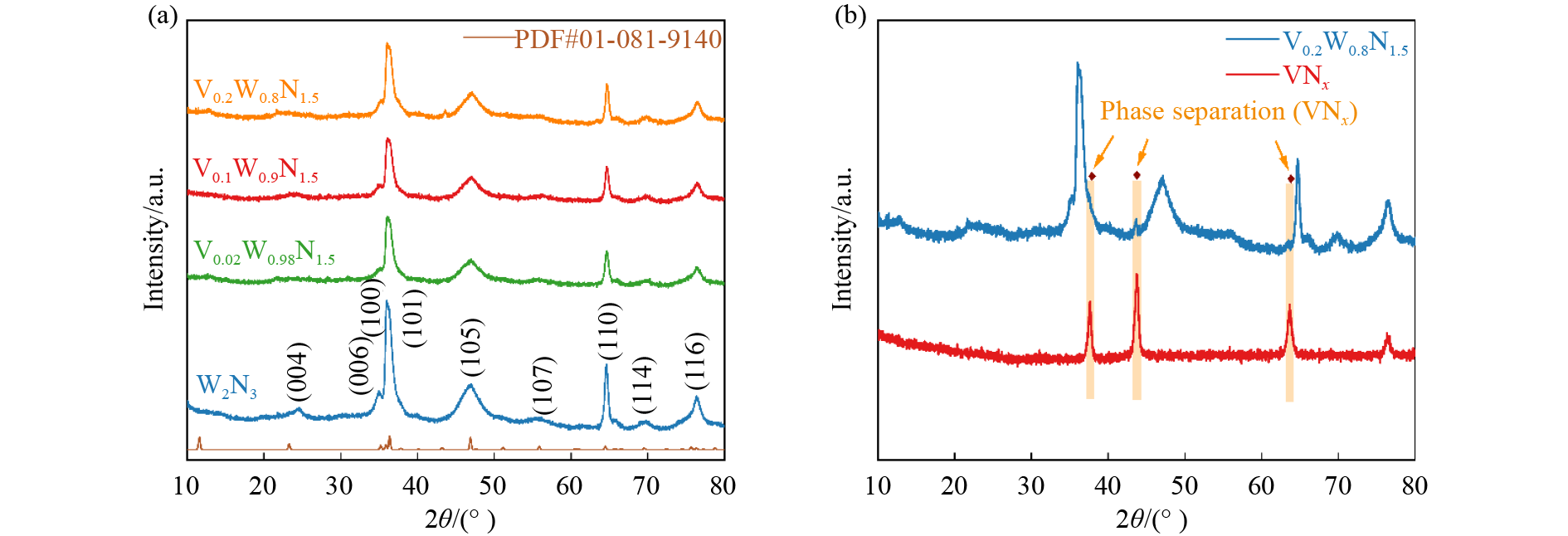

Syngas production by photoreforming of formic acid with 2D VxW1−xN1.5 solid solution as an efficient cocatalyst
Received date: 28 Nov 2023
Accepted date: 24 Jan 2024
Copyright
Formic acid (FA) is a potential biomass resource of syngas with contents of carbon monoxide (CO, 60 wt.%) and hydrogen (H2, 4.4 wt.%). Among the technologies for FA conversion, the photoreforming of FA has received widespread attention due to its use of green solar energy conversion technology and mild reaction conditions. Herein, a V–W bimetallic solid solution, VxW1−xN1.5 with efficient co-catalytic properties was first and facilely synthesized. When CdS was used as a photocatalyst, the activity performance of the V0.1W0.9N1.5 system was over 60% higher than that of the W2N3 system. The computational simulations and experiments showed the V0.1W0.9N1.5 had great metallic features and large work functions, contributing a faster photo-generated carrier transfer and less recombination, finally facilitating a great performance in cocatalyst for syngas production in photoreforming FA. This work provides an approach to synthesizing novel transition metal nitrides for photocatalysis.

Key words: photocatalysis; syngas; formic acid; cocatalyst; solid solution
Xiaoyuan Ye , Yuchen Dong , Ziying Zhang , Wengao Zeng , Bin Zhu , Tuo Zhang , Ze Gao , Anna Dai , Xiangjiu Guan . Syngas production by photoreforming of formic acid with 2D VxW1−xN1.5 solid solution as an efficient cocatalyst[J]. Frontiers in Energy, . DOI: 10.1007/s11708-024-0940-x
| 1 |
Qi L , Mui Y F , Lo S W .
|
| 2 |
Voß D , Pickel H , Albert J . Improving the fractionated catalytic oxidation of lignocellulosic biomass to formic acid and cellulose by using design of experiments. ACS Sustainable Chemistry & Engineering, 2019, 7(11): 9754–9762
|
| 3 |
Kato N , Mizuno S , Shiozawa M .
|
| 4 |
Antón-García D , Edwardes Moore E , Bajada M A .
|
| 5 |
Wei D , Sang R , Sponholz P .
|
| 6 |
Schwarz F M , Moon J , Oswald F .
|
| 7 |
Zhai S , Jiang S , Liu C .
|
| 8 |
Pan H , Heagy M D . Photons to formate: A review on photocatalytic reduction of CO2 to formic acid. Nanomaterials, 2020, 10(12): 2422
|
| 9 |
Chen Z , Junge H , Beller M . Amino acid promoted hydrogen battery system using Mn-pincer complex for reversible CO2 hydrogenation to formic acid. Frontiers in Energy, 2022, 16(5): 697–699
|
| 10 |
Chen X , Jin F . Photocatalytic reduction of carbon dioxide by titanium oxide-based semiconductors to produce fuels. Frontiers in Energy, 2019, 13(2): 207–220
|
| 11 |
Hu X , Jin J , Wang Y .
|
| 12 |
Zhou H , Wang M , Wang F . Oxygen-controlled photo-reforming of biopolyols to CO over Z-scheme CdS@g-C3N4. Chem, 2022, 8(2): 465–479
|
| 13 |
Gao Y , Hu E , Huang B .
|
| 14 |
Liang Z , Song L , Sun M .
|
| 15 |
Guo S , Zhao S , Wu X .
|
| 16 |
Andrei V , Reuillard B , Reisner E . Bias-free solar syngas production by integrating a molecular cobalt catalyst with perovskite–BiVO4 tandems. Nature Materials, 2020, 19(2): 189–194
|
| 17 |
Toe C Y , Tsounis C , Zhang J .
|
| 18 |
Puga A V . Photocatalytic production of hydrogen from biomass-derived feedstocks. Coordination Chemistry Reviews, 2016, 315: 1–66
|
| 19 |
Zhang Z Y , Cao S W , Liao Y S .
|
| 20 |
Xiao L , Jun Y S , Wu B .
|
| 21 |
Li Y X , Hu Y F , Peng S Q .
|
| 22 |
Wang T , Yang L , Jiang D .
|
| 23 |
Cao S , Chen Y , Wang H .
|
| 24 |
Zhou P , Zhang Q , Xu Z .
|
| 25 |
Wang Y L , Nie T , Li Y H .
|
| 26 |
Wang T , Chen M , Wu J .
|
| 27 |
Ye X , Dong Y , Zhang Z .
|
| 28 |
Wang H , Li J , Li K .
|
| 29 |
Tang Y , Yang C , Xu X .
|
| 30 |
Chen Z , Song Y , Cai J .
|
| 31 |
Zhang H M, Wang J J, Meng Y, et al. Review on intrinsic electrocatalytic activity of transition metal nitrides on HER. Energy Material Advances. 2022, 2022: 0006
|
| 32 |
Jin H , Yu H , Li H .
|
| 33 |
Jin H , Li L , Liu X .
|
| 34 |
Wang S , Yu X , Lin Z .
|
| 35 |
Zhang K , Kim J K , Park B .
|
| 36 |
Tian B , Gao W , Zhang X .
|
| 37 |
Li R , Takata T , Zhang B .
|
| 38 |
Qi M Y , Li Y H , Zhang F .
|
/
| 〈 |
|
〉 |